George W. Stimson introduction to Airborne Radar (Se)
Подождите немного. Документ загружается.

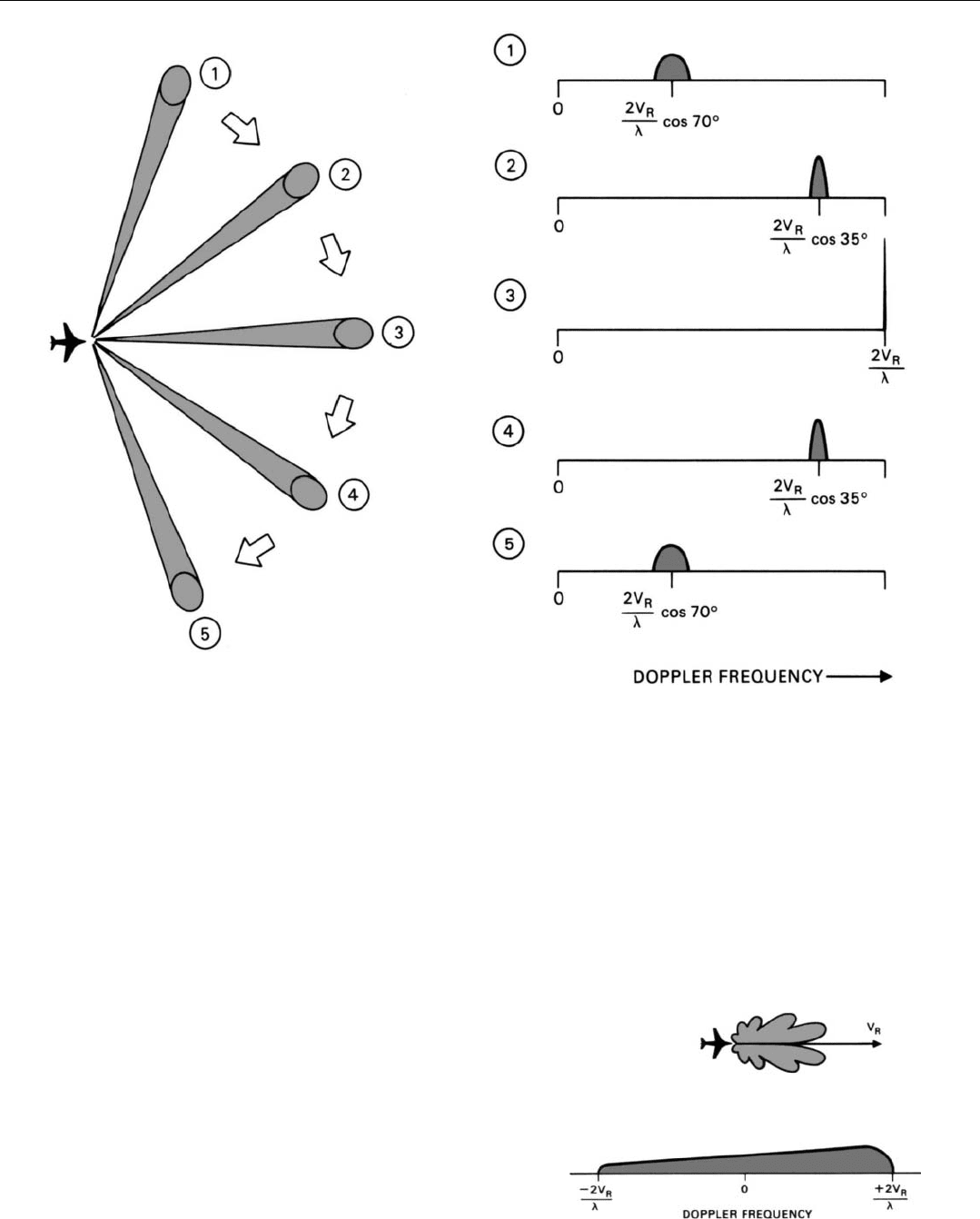
and the wider the band of frequencies it occupies, the high-
er the angular resolution that can be obtained through
doppler processing.
Sidelobe Clutter
The radar return received through the antenna’s side-
lobes is always undesirable and so is called sidelobe clutter
(SLC). Excluding the altitude return, sidelobe clutter is not
nearly as concentrated (less power per unit of doppler fre-
quency) as mainlobe clutter. But it covers a much wider
band of frequencies.
Frequency and Power. Sidelobes extend in virtually all
directions, even to the rear. Therefore, regardless of the
antenna look angle, there are always sidelobes pointing
ahead, behind, and at virtually every angle in between. As a
result, the band of frequencies covered by the sidelobe clut-
ter extends from a positive frequency corresponding to the
radar’s velocity (f
d
= 2V
R
/λ) to an equal negative (less than
the transmitter’s) frequency (Fig. 15).
CHAPTER 22 Sources and Spectra of Ground Return
299
15. Because sidelobes are radiated in all directions, sidelobe clut-
ter extends from a positive frequency corresponding to the
radar’s velocity to an equal negative frequency.
14. As the antenna beam sweeps through its search scan, the mainlobe clutter spectrum moves out to its maximum frequency and squeezes into
a narrow line, then returns again.
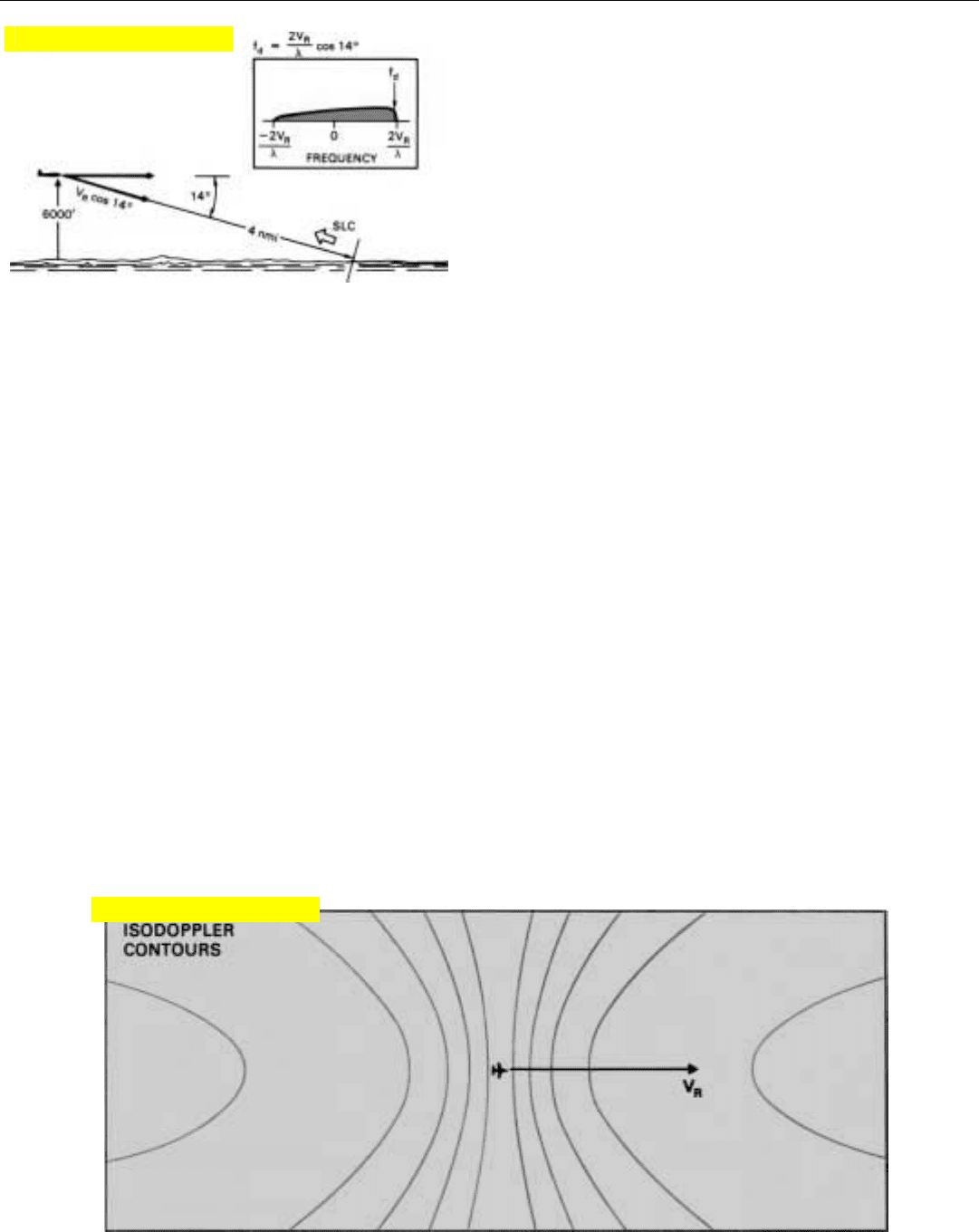
PART V Return from the Ground
300
While the power radiated in any one direction through
the sidelobes is relatively slight, the area illuminated by the
sidelobes is extremely large. Moreover, much of the clutter
comes from relatively short ranges. This is so, even out to
the ends of the sidelobe clutter spectrum. As illustrated in
Fig. 16, since the cosine of a small angle is nearly equal to
one, if a radar is at an altitude of 6000 feet, return from a
range of only 4 nautical miles (depression angle = 14°) will
have a doppler frequency only 3 percent less than the maxi-
mum (2V
R
/λ).
In aggregate, therefore, not only can the sidelobe clutter
power be substantial, but the clutter may be spread more
or less uniformly over a broad band of doppler frequen-
cies.
Impact on Target Detection. The extent to which the
clutter interferes with target detection depends on the fre-
quency discrimination the radar provides. This is illustrated
by the map in Fig. 17 (below).
Plotted on it are lines of constant doppler frequency.
They are called isodoppler contours. Each line represents
the intersection between the ground and the surface of a
cone around the radar’s velocity vector. Since the angle
between this vector and every point on the cone is the
same, the return from every point along the contour has the
same doppler frequency. Just as the distances between con-
tour lines on a relief map correspond to a fixed interval of
elevation, so the distances between isodoppler lines corre-
spond to a fixed interval of doppler frequency.
Let us suppose now that the doppler interval corre-
sponds to the minimum difference in doppler frequency
which can be discerned by a particular radar—i.e., its
doppler resolution. If the radar differentiates between tar-
16. At an altitude of 6,000 feet, sidelobe return from a range of
only 4 nautical miles will have a doppler frequency almost
equal to the maximum sidelobe clutter frequency.
17. Lines of constant doppler frequency—isodoppler contours. Each corresponds to the intersection of a cone about
the radar’s velocity vector with the ground.
Click for high-quality image
Click for high-quality image
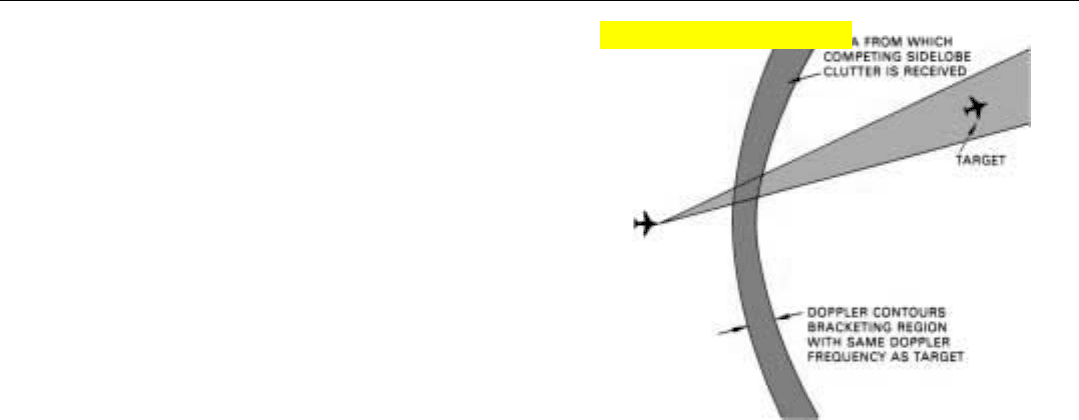
gets and clutter solely on the basis of doppler frequency, a
target falling amid the sidelobe clutter must compete with
the return from the entire strip of ground between the con-
tours bracketing the target’s doppler frequency.
And, as is made clear in Fig. 18, depending upon the tar-
get’s range rate, much of this ground may be at substantially
closer range than the target.
To appreciate this point, bear in mind that the strength
of radar return is inversely proportional to the fourth power
of the range from which it is received. For given values of
antenna gain and backscattering coefficient, the power of
the return from a ground patch at a range of, say, 1 mile is
(10/1)
4
= 10,000 times (40 dB greater than) that of the
return from a ground patch of the same size at a range of 10
miles.
If the radar also provides range resolution (as by range
gating), the target must compete only with that portion of
the clutter passed by the same range gate as the target’s
echoes.
Other Factors Governing Sidelobe Clutter Strength.
The strength of the sidelobe return from any one patch of
ground depends upon several factors besides range. One is
the gain of the particular sidelobe within which the patch
lies. In a representative fighter radar, the two-way gain of
the first sidelobe beyond the mainlobe is on the order of
100 times (20 dB) stronger than that of the weaker side-
lobes.
The strength of the return also varies widely with the
nature of the terrain included in the patch—its backscatter-
ing coefficient.
As explained previously, as the grazing angle increases,
the backscattering coefficient also increases. Consequently,
even though a radar is closer to the ground at low altitudes,
sidelobe clutter may be most severe when flying at moder-
ate rather than low altitudes.
Significance. Clearly, the extent to which sidelobe clutter
is a problem depends upon many things.
• Frequency resolution provided by the radar
• Range resolution provided by the radar
• Gain of the sidelobes
• Altitude of the radar
• Backscattering coefficient and angle of incidence
Also, as already noted, certain man-made objects can be
immensely important sources of sidelobe clutter. (They will
be discussed separately at the end of this chapter.)
CHAPTER 22 Sources and Spectra of Ground Return
301
18. If a radar differentiates between target echoes and ground
return solely on basis of doppler frequency, sidelobe clutter
can present a serious problem.
Click for high-quality image

PART V Return from the Ground
302
This return is called the altitude return, since generally its
range equals the radar’s absolute altitude.
Relative Strength. The altitude return is not only much
stronger than the surrounding sidelobe clutter but may be
as strong or stronger than the mainlobe clutter.
2
For, the
area from which it comes not only may be very large but is
often at extremely close range.
This point is illustrated in Fig. 20. A radar is at an alti-
tude (h) of 6000 feet over flat terrain. As you can see, the
slant range to the ground at an angle of incidence
θ
equals
h/cos
θ
. The cosine of a small angle being only slightly less
than one, even when
θ
is as much as 22° the slant range to
the ground is only 500 feet greater than the altitude (verti-
cal range).
If the slant range at an angle of incidence of 22° is rotat-
ed about the vertical axis, it traces a circle on the ground
having a diameter of roughly 5000 feet (Fig. 21).
A circle this size contains nearly 20 million square feet.
Thus, the radar receives all of the return from a 20-million-
square-foot area, at a range of just 1 nautical mile, in the
round-trip transit time for a range increment of 500 feet.
That time is only 1 microsecond.
Furthermore, at near vertical incidence, the backscatter-
ing coefficient tends to be very large. Over water, the coeffi-
cient is enormous. Little wonder, then, that the altitude
return appears as a sharp spike in a plot of amplitude ver-
sus range.
Doppler Frequency. The altitude return peaks up in a
plot of amplitude versus frequency, too, but not sharply.
The reason can be seen from Fig. 22 at the top of the facing
page.
20. At an altitude of 6,000 feet, even at an angle of incidence
θ
of 22˚, the slant range to the ground is only 500 feet greater
than the altitude.
21. Yet, at an altitude of 6,000 feet, an angle of incidence of 22˚
encompasses a circle having an area of 20 million square feet.
Altitude Return
Beneath an aircraft, there is usually a region of consider-
able extent within which the ground is so close to being at a
single range that the sidelobe return from it appears as a
spike on a plot of amplitude versus range (Fig. 19).
19. Altitude return comes from a large area, often at very close
range.
2. In the case of an altimeter, the
mainlobe return is the altitude
return.

The projection of the radar velocity, V
R
, on the slant
range to the ground equals V
R
sin
θ
. Unlike the cosine, the
sine of an angle changes most rapidly as the angle goes
through zero. While the doppler frequency of the clutter is
zero when θ is zero, it increases to nearly 40 percent of its
maximum value (2 V
R
/λ) at an angle
θ
of only 22°. Return
from a circle of ground that produces a sharp spike in a
plot of amplitude versus range, therefore, produces only a
broad hump in a plot of amplitude versus doppler fre-
quency (Fig. 23).
CHAPTER 22 Sources and Spectra of Ground Return
303
23. Since sine
θ
changes most rapidly as
θ
goes through zero,
altitude return is spread over a comparatively broad band of
doppler frequencies.
24. Doppler frequency of altitude return is normally low, but may
be quite high in a dive.
Normally, the doppler frequency of the altitude return is
centered at zero. However, if the altitude of the radar is
changing—as when the aircraft is climbing, diving, or flying
over sloping terrain—this will not be so. For a dive, the
doppler frequency will be positive (Fig. 24); for a climb, it
will be negative. Even though the frequency is generally
fairly low, it can be considerable. In a 30° dive, for instance,
the altitude would be changing at a rate equal to half the
radar velocity.
Significance. Despite its strength, the altitude return is
usually less difficult to deal with than the other ground
returns. Not only does it come from a single range, but its
range is predictable; and, as we have seen, its frequency is
generally close to zero—though that unfortunately is the
doppler frequency of a target pursued at constant range
(e.g., a tail chase with zero closing rate, R
⋅
= 0).
Relation of Clutter Spectrum to Target Frequencies
Having become familiar with the characteristics of main-
lobe clutter, sidelobe clutter, and altitude return individual-
ly, let us look briefly at the composite clutter spectrum and
its relationship to the frequencies of the echoes from repre-
22. Doppler frequency of return from a given angle of incidence,
θ, is proportional to projection of radar velocity onto slant
range at that angle, hence to the sine of θ.
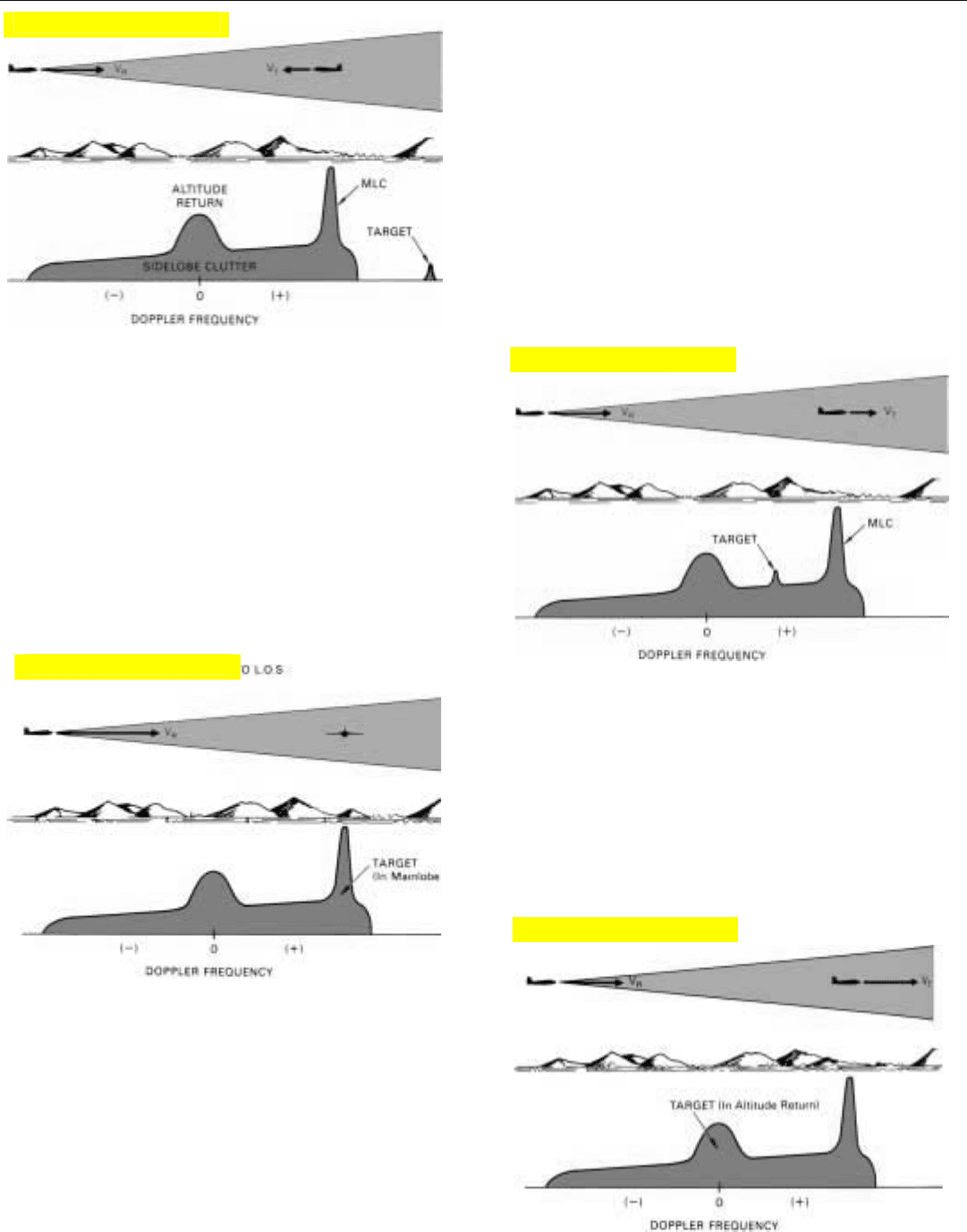
PART V Return from the Ground
304
sentative airborne targets in typical operational situations.
Again, we will assume that the PRF is high enough to avoid
doppler ambiguities.
Figure 25 illustrates the relationship between target and
clutter frequencies for a nose-aspect approach. Because the
target’s closing rate is greater than the radar’s velocity, the
target’s doppler frequency is greater than that of any of the
ground return.
Figure 26 (below) shows the relationship for a tail chase.
Because the target’s range rate is less than the radar’s veloci-
ty, the target’s doppler frequency falls within the band of
sidelobe clutter. Just where, depends upon the range rate.
26. Doppler frequency of target falls within sidelobe clutter.
27. Target is buried in mainlobe clutter. Fortunately, a target will
attain such a relationship only occasionally and usually will
remain in it fleetingly.
28. Target is buried in altitude return.
25. Doppler frequency of target is greater than that of any ground
return.
In Fig. 27, the target’s velocity is perpendicular to the
line of sight from the radar; the target has the same doppler
frequency as the mainlobe clutter. Fortunately, a target will
attain such a relationship only occasionally and usually will
remain in it fleetingly.
In Fig. 28, the target’s closing rate is zero; the target has
the same doppler frequency as the altitude return.
TAIL CHASE, ZERO CLOSING RATE (V
R
= V
T
)
Click for high-quality image
Click for high-quality image
Click for high-quality image
Click for high-quality image

Figure 29 shows two opening targets. Target A has an
opening rate that is greater than the radar’s ground speed
(V
R
), so this target appears in the clear beyond the negative-
frequency end of the sidelobe clutter spectrum. On the
other hand, Target B has an opening rate less than V
R
. So
this target appears within the negative frequency portion of
the sidelobe clutter spectrum.
With these situations as a guide, the relationship of the
doppler frequencies of target return and ground return for
virtually any situation can easily be pictured (Fig. 30). Bear
in mind, though, that at lower PRFs doppler ambiguities
can occur which may cause a target and a ground patch
having quite different range rates to appear to have the
same doppler frequency.
The consequences of such ambiguities will be discussed
in detail in the next chapter. The signal processing com-
monly performed to separate target echoes from ground
clutter in the various operational situations presented here,
as well as when operating at PRFs which make doppler fre-
quencies ambiguous, will be described in Chaps. 26, 27,
and 28.
CHAPTER 22 Sources and Spectra of Ground Return
305
30. Relationships between target doppler frequency and ground-clutter spectrum for various target closing rates. (Doppler frequencies assumed
to be unambiguous.)
29. If range rate is more negative than –VR, target appears in
clear (A) below sidelobe clutter spectrum; otherwise, it
appears in negative frequency half of the spectrum (B).
Click for high-quality image
Click for high-quality image
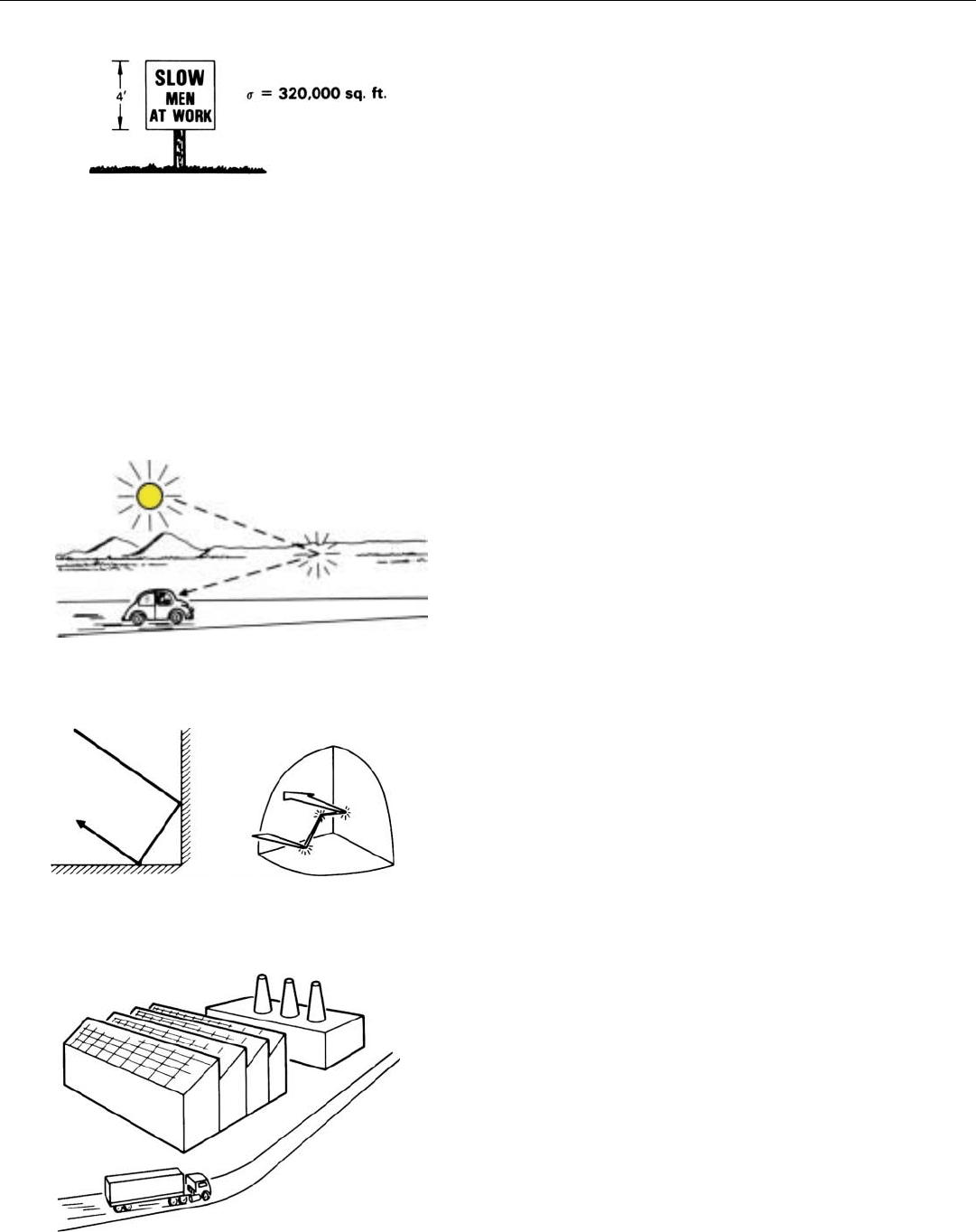
PART V Return from the Ground
306
Return from Objects on the Terrain
The return from certain man-made structures can be
very strong. Viewed straight on by an X-band radar, a
smooth, flat metal sign only 4 feet on a side, for example,
has a radar cross section on the order of 320,000 square
feet (Fig. 31) compared to 10 square feet or less for a small
aircraft in some aspects.
This may sound absurd, but not if you stop to think.
Most of the power intercepted by the sign when viewed
straight-on will be reflected back in the direction of the
radar. The sign is a specular (mirrorlike) reflector. It acts, in
fact, just like an antenna that is trained on the radar and
reradiates all of the transmitted power it intercepts, back in
the radar’s direction. At X-band frequencies, for example,
an antenna with a 16-square foot aperture has a gain of
around 20,000. Multiply the area of the sign by this gain
(16 x 20,000) and you get a radar cross section of 320,000
square feet.
In principle, the radar return from a flat reflecting sur-
face, such as a sign, is directly comparable to the intense
reflections one frequently gets from the windshield of a car
or the window of a hillside house when it is struck from
just the right angle by the early morning or late afternoon
sun (Fig. 32).
Whereas a single flat surface such as a sign must be
viewed from nearly straight-on to reflect the incident ener-
gy back to the radar, two surfaces forming a 90° corner
will do so over a wide range of angles in a plane normal to
the intersection of the surfaces. They are what is called
retroreflective. If a third surface is added at right angles to
the other two (forming a corner reflector), the range of
angles over which the surfaces will be retroreflective may be
increased to nearly a quarter of a hemisphere (Fig. 33).
This, incidentally, is the way bicycle reflectors work.
Portions of a large building may act like corner reflectors,
and a vehicle such as a truck may look like a group of cor-
ner reflectors (Fig. 34).
Because of their enormous radar cross sections, retro-
reflective objects on the ground can produce sidelobe
return as strong or stronger than the echoes from distant
aircraft received through the mainlobe. Furthermore,
because the objects are of limited geographic extent—they
are discrete as opposed to distributed reflectors—all of the
return from one of them has very nearly the same doppler
frequency and comes from very nearly the same range. The
return may appear to the radar, therefore, exactly as if it
came from an aircraft in the mainlobe.
Naturally, since these objects are virtually all man-made,
they are much more numerous in urban than in rural areas.
31. Viewed straight-on, a smooth
3
flat plate can have an immense
radar cross section.
3. The surface variations are
small in comparison to a
wavelength.
32. Radar echoes from certain man-made objects on the ground
are comparable to reflection from a window struck from just
the right angle by the sun.
33. Corner formed by two flat surfaces is retroreflective over wide
range of angles; that formed by three surfaces, over wider
range still.
34. Portions of a building may act like corner reflectors; a truck
like several corner reflectors.
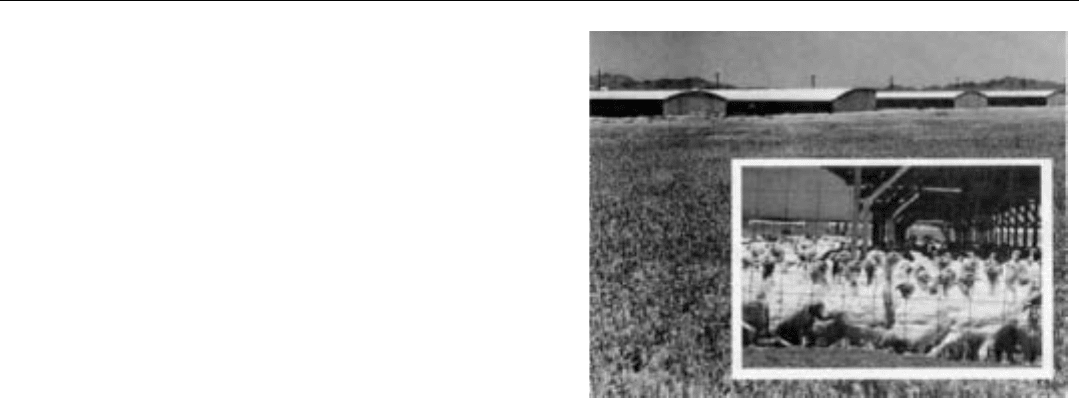
Nevertheless, they may be encountered almost anywhere.
In the little populated region of Southern California’s
Antelope Valley, for example, the long, low corrugated
metal sheds of the turkey ranchers (Fig. 35) return tremen-
dously strong echoes.
Depending on the use of the radar, special measures may
be required to reduce or eliminate sidelobe return of this
sort. Mainlobe return from such objects is usually not a
problem, since its doppler frequency is generally different
from that of targets of interest. But if the objects are moving
or have extraordinarily large radar cross sections, the main-
lobe return, too, can be a problem.
Summary
The same factors govern the power of ground return as
that from an aircraft. Backscattering from the ground, how-
ever, is expressed in terms of an incremental coefficient,
σ
o
,
which must be multiplied by the area of a ground patch to
obtain its radar cross section,
σ
. The coefficient
σ
o
varies
with angle of incidence, frequency, polarization, electrical
characteristics of the ground, roughness of the terrain, and
nature of the objects on it. Generally, the variation with
angle is due primarily to foreshortening of the ground area
as viewed from the radar.
The most important ground return—and the only return
of interest for ground mapping etc.—is that received
through the antenna’s mainlobe. When the antenna is look-
ing straight ahead, the doppler frequency of this return cor-
responds to the radar’s full ground speed. As the look angle
increases, the frequency decreases and spreads over an
increasingly broad band. Both the center frequency and the
width of this band increase directly with the radar’s velocity
and are inversely proportional to wavelength.
Ground return received through the sidelobes, though
comparatively weak at any one frequency, extends from a
positive frequency corresponding to the radar’s full velocity
(2V
R
/λ) to an equal negative frequency. The portion
received from directly below—the altitude return—is espe-
cially strong, particularly over water. It appears as a spike
on a plot of amplitude versus range and as a broad hump
on the doppler spectrum. Its center doppler frequency is
normally zero.
Man-made objects on the ground may be highly retro-
reflective and can produce sidelobe return as strong as tar-
get echoes received through the mainlobe.
If the PRF is high enough to eliminate ambiguities,
whether a target’s echoes and the ground return have differ-
ent doppler frequencies—as is desirable for ground clutter
rejection—depends upon the target’s closing rate. As long
CHAPTER 22 Sources and Spectra of Ground Return
307
35. Even in little populated regions, there may be numerous struc-
tures having tremendous radar cross sections.

PART V Return from the Ground
308
as it is greater than the radar’s velocity, the echoes will lie
outside the ground return. Otherwise, they must compete
with sidelobe return. Only if the target is flying at right
angles to the line of sight from the radar, will its echoes
have the same frequency as the mainlobe return. Only if the
closing rate is zero, will the target echoes have the same fre-
quency as the altitude return.
However, as we shall see in the next chapter, doppler
ambiguities can cause a target and ground patches, having
quite different range rates, to appear to have the same
doppler frequency, thereby greatly compounding the prob-
lem of separating target echoes from clutter.
